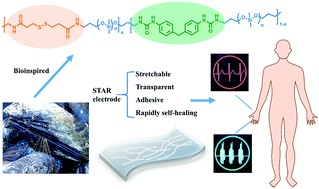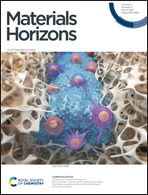A Lamellibranchia-inspired epidermal electrode for electrophysiology†
Abstract
The capability to accurately monitor electrophysiological signals and instantly provide feedback to users is crucial for wearable healthcare. However, commercial gel electrodes suffer from drying out and irritation on skin with time, severely affecting signal quality for practical use. Toward a gel-free electrophysiology, epidermal electrodes that can accurately detect biosignals and simultaneously achieve the multifunctional properties of on-skin electronics needs are highly desirable. In this work, inspired by Lamellibranchia, which can adhere tightly to various surfaces using their extensible, adhesive and self-healing byssal threads, we developed a gel-free epidermal electrode to acquire high-quality electrophysiological signals based on a novel polymer substrate design. This polymer (STAR) features extreme stretchability (>2300% strain), high transparency (>90% transmittance at λ = 550 nm), gentle adhesion (adhesion strengths: tens of kPa), and rapid self-healing ability (95% healing efficiency in 10 min). Combined with silver nanowires as conductors, STAR was employed as a self-healing, stretchable and adhesive epidermal electrode for electrophysiological signal recording, showing a signal-to-noise ratio (SNR) even higher than that of commercial electrodes, and being able to control an artificial limb as an intermediate for human–machine interface. We believe our Lamellibranchia inspired STAR will pave a new way to design multifunctional polymers for epidermal electronics, accelerating the development of emerging wearable healthcare.

- This article is part of the themed collection: Materials Horizons Emerging Investigators Series 2020/2021


 Please wait while we load your content...
Please wait while we load your content...